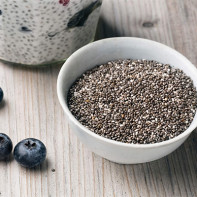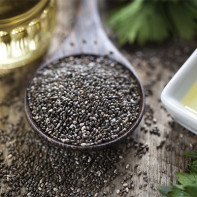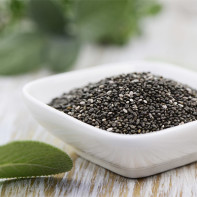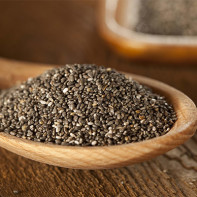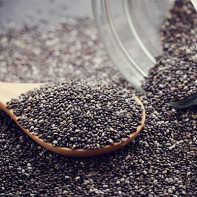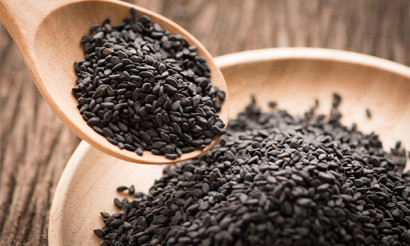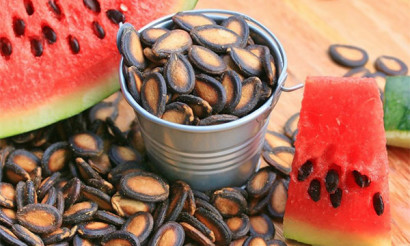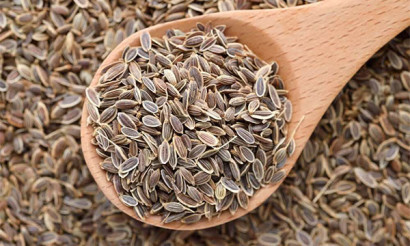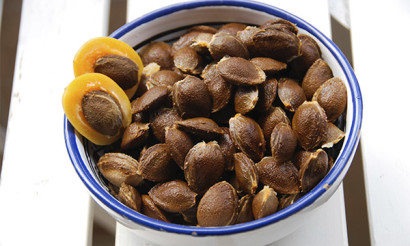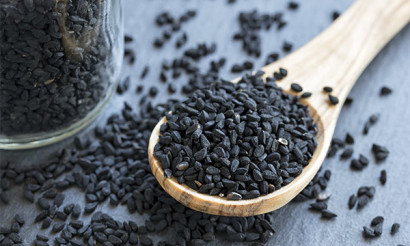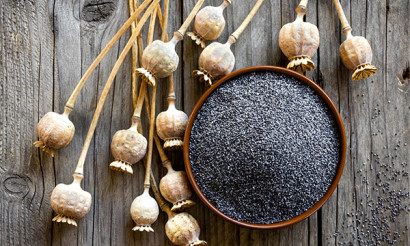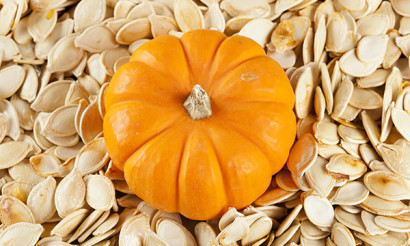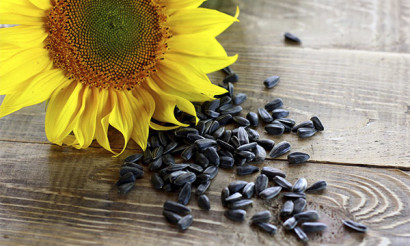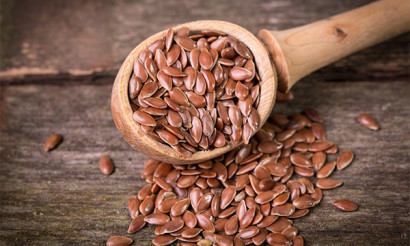Chia seeds: benefits and harm to the body
If you search well, then in almost every corner of the globe you can find amazing plants that have many useful properties. They can be used for treatment instead of the usual medicines. We live in a wonderful time that allows us to get acquainted with foods and herbs from anywhere in the world. One of these products will be discussed in this article.
- What are chia seeds
- Views
- Composition and calorie content
- The beneficial properties of chia seeds
- General benefit
- For women
- For men
- During pregnancy
- When breastfeeding
- For children
- How to take chia seeds for weight loss
- Chia seed oil: properties and applications
- Chia seeds in medicine
- With diabetes
- With pancreatitis
- With gastritis
- For the intestines
- For constipation
- With gout
- Chia seeds in cosmetology
- For face
- For hair
- Harm and contraindications
- How to choose and store chia seeds
- How to use chia seeds
- How much can you eat per day
- Can I eat at night and on an empty stomach
- Do I need to wash chia seeds before eating
- What can be prepared from chia seeds: recipes
- Porridge
- Smoothie
- Pudding
- Interesting Facts About Chia Seeds
Chia seeds (another name is Spanish sage), despite their strange name, have gained quite wide popularity, especially recently. Chia seeds have found their application in the field of medicine and can act as a medicine for many ailments, used in the field of cooking, and they can also be used to get rid of extra pounds.
What are chia seeds
The homeland of chia seeds are considered the countries of Central America. Spanish sage, as a rule, grows on elevations (up to 2 kilometers) above sea level. The height of the plant ranges from half a meter to 1 meter. The structure is branched, on the stem are leaves, the width of which can reach 5 cm and a length of 8 cm, as well as beautiful flowers of violet-blue or white.
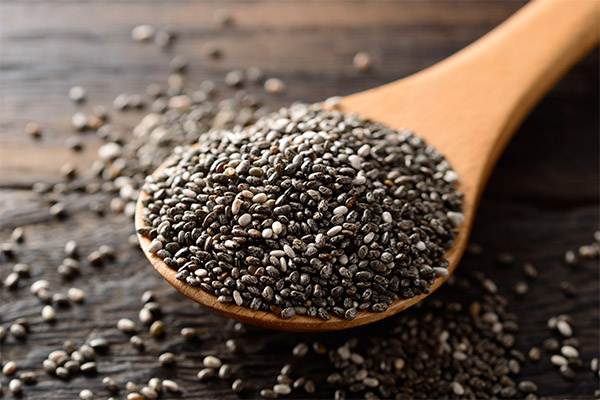
Seeds are oval. The seeds are small, with a diameter of only 1 mm. White, grayish, dark and brownish seeds can be found, and they are identical in use. The taste of the grains is neutral, but there may be a nutty note.
Until today, it is not known exactly why the plant has such a name. According to some reports, it came from the word "chiabaan" from the Mayan language, which in translation means "strengthening." Other experts say that the name was given to the plant by the Aztecs. In their dialect there is the word "chian", translated as "bold". At the same time, both peoples used grains for cooking. Medicinal products and paints for tattoos were also made from seeds.
Views
Plant seeds can be divided into 2 types - white and black. Each of the species is enriched with many useful substances, while there are some differences regarding the nutritional value of products.
- White. Seeds are extracted from plants with white flowers. The grains contain vitamins A, B1, B2, C, K, PP, and they are also rich in iron, copper, manganese, potassium, zinc, phosphorus and molybdenum. White seeds are very popular and valuable due to their composition. A large number of proteins and fats make the product a tool that helps to normalize hormonal balance and supports the functioning of the cardiovascular system.
- Black. This type of seed is practically not inferior to white. The product is also rich in useful substances, but at the same time differs in their lower concentration. Black grains, unlike white grains, are more accessible. They contain the same vitamins and minerals as in white. This type is great for people who suffer from symptoms of diabetes, since the substances contained in the seeds help to normalize glucose levels and also help the body interact with insulin.
Composition and calorie content
100 g of product contain:
- calories - 392;
- proteins - 21.2 g;
- fats - 31.4 g;
- carbohydrates - 37.5 g.
The product also contains omega-3 and omega-6 fatty acids and fiber. The product is rich in vitamins A, B1, B2, C, K, PP, as well as potassium, calcium, magnesium, zinc, selenium, copper, manganese, iron, phosphorus and sodium.
The beneficial properties of chia seeds

General benefit
- The benefits of losing weight. Chia seeds effectively help fight extra pounds. The main reason for their effectiveness is the content of dietary fiber in the product. They are able to absorb a large amount of liquid, as a result of which the stomach is filled, which ultimately makes a person feel full, since the absorption of food slows down. Seeds are usually used as a supplement to the main diet.
- Fight against cancer. The seeds contain a large amount of antioxidants and alpha-linolenic acid, substances that inhibit carcinogenic processes and prevent the development of tumors. The most effective grain manifest themselves in the fight against breast cancer. Alpha-linolenic acid destroys the cells responsible for the development of oncology, while not affecting healthy ones.
- Normalization of the digestive processes. Due to the large amount of fiber contained in the seeds, they have a positive effect on digestion. Seeds support digestive processes, prevent constipation and regulate the rhythm of the intestines. They also help to absorb nutrients. Nevertheless, it is very important that chia seeds are not used for inflammatory bowel diseases and other digestive tract pathologies.
- Positive effect on the heart. Potassium contained in the seeds helps reduce pressure, so this product is recommended to be included in the diet of people suffering from hypertension and heart disease. In fact, in the case of regular use of the seeds of this plant, after a while you can notice a decrease in blood pressure. It is worth noting that the product contains omega-3 fats and fiber, which have a positive effect on the cardiovascular system. They lower the level of “bad” LDL cholesterol and triglycerides, while increasing the level of good HDL cholesterol. Thanks to this body, it is easier to cope with various heart diseases, including coronary heart disease and atherosclerosis. In addition, potassium, sodium, calcium and magnesium support heart function, thereby effectively reducing the risk of heart attack.
- Improves brain function. Chia seeds in their composition contain a lot of magnesium, which affects the quality of sleep, helps in the fight against chronic fatigue and reduces muscle cramps. Thanks to its high magnesium content, eating grains helps combat nervousness and a strong susceptibility to stress. In addition, the omega-3 fatty acids contained in the product improve brain function, memory and concentration, as well as facilitate learning and memory. Therefore, it is especially recommended to include them in the diet of people performing regular mental work, as well as children of preschool and school age.
- Support for healthy hair, skin and nails. The antioxidants contained in the seeds protect the body from the effects of free radicals, that is, compounds that affect the rate of skin aging processes. In addition to antioxidants, vitamin E and omega-3 acids also affect skin condition. They counteract atopic dermatitis. In addition, the seeds of Spanish sage contain calcium, iron and zinc, which significantly improve the condition of hair and nails.
- Improving the health of bones and teeth. Spanish sage contains much more calcium than dairy products. Therefore, this product is recommended to be used in cases of shortage of this macrocell. In addition, the phosphorus contained in the grains gives the teeth and bones greater strength and makes them less prone to fractures.
- Immunity support. Chia seeds have a huge impact on the body's resistance to various diseases and general condition.The fatty acids contained in the product prevent autoimmune diseases and strengthen the immune system. In addition, the arginine they contain improves and accelerates wound healing.
- Normalization of hormonal balance. Chia seeds contain lignans, which are very important for health. These are phytochemical compounds responsible for regulating the level of hormones in the body. That is why the seeds are recommended for women during menopause. Chia seeds help maintain hormonal balance. In addition, the high content of antioxidants, minerals and vitamins gives the body energy, which makes you feel better.
- Eye benefit. Omega-3 fatty acids found in chia seeds have a positive effect on vision, especially when it comes to older people. Regular use of this product reduces the risk of macular degeneration.
- Source of energy. Mayan tribes used chia seeds as a means that saturates the body and gives energy. The product can provide a great service to people who regularly visit the gym, as well as those who have work associated with heavy physical exertion.
- Alternative to eggs. Seeds are ideal for vegans and egg allergy sufferers. Due to its gelatinous properties, in contact with a liquid, grains are an ideal substitute for eggs in various dishes. To prepare chia seeds as an egg substitute, simply mix 1 tablespoon of chia seeds with 3 tablespoons of water. Then you need to leave the product for 15 minutes, after which it can already be used.
- Gluten free product. Some people may have gluten intolerance. Chia seeds, which have the texture and characteristics of cereals, do not contain gluten, so they can be safely used in this case.
- Source of protein. Chia seeds contain a lot of protein, but they do not have cholesterol. Proteins help the body form new cells and play a structural role in the functioning of tissues. A small handful of seeds contains about 10% of the recommended daily intake of protein. This is not characteristic of plant seeds, since most protein-rich foods are meat.
- Getting rid of heartburn. The healing properties of chia seeds can be used to treat irritable bowel or heartburn. Heartburn occurs when stomach acid enters the esophagus. Chia seeds help get rid of stomach acid and pain.
- Involved in cell repair. After operations, injuries, or simply after a hard workout, the body needs to work hard to repair damaged cells. Trace elements, vitamins, omega-3 acids and amino acids contained in the product contribute to cell regeneration.
For women
Women are recommended to use seeds during menopause, as they help normalize hormonal levels, have a positive effect on well-being and alleviate stressful conditions. Seeds also contribute to the normalization of the menstrual cycle and relieve pain during menstruation.
For men
Men are encouraged to use this product as a prophylactic against prostate cancer. Also, seeds help maintain a sufficient level of physical endurance in case of intense exertion. This product is equally important for maintaining and strengthening the health of the reproductive system. Seeds are recommended for use during pregnancy planning to improve sperm quality. Also, the product is able to perfectly saturate the body, since even a small handful of seeds will be enough to feel normal throughout the day.
During pregnancy
During pregnancy, chia seeds support the processes associated with the development of the child, as well as heal the female body and improve the well-being of the mother. Grains also saturate the body with minerals and vitamins.Phosphorus and zinc present in the product will support the body during the period of gestation, as well as strengthen the immune system. In addition, the seeds will help in the development of the nervous system, and also have a positive effect on the brain of the fetus.
With all the benefits of the product, you should pay attention to a possible allergy. If a woman has previously experienced an allergic reaction to sesame or mustard, then chia seeds must be excluded from the diet. In any case, risking and experimenting with the product is not worth it, as this can adversely affect the child. It is also important to remember moderation in consumption, especially in case of digestive problems.
When breastfeeding
It is allowed to consume seeds during lactation, but again it is necessary to observe moderation. After 2 months of breastfeeding, you can already gradually incorporate this product into your diet. Begin with 1 teaspoon of grains, no more. After taking, you need to follow the reaction of the baby. If no side effects have occurred, then you can continue to use the ingredient. After some time, the daily dosage of seeds is allowed to be increased to 2 two tablespoons.
After 7 days of use, you need to take a 2-day break. Seeds can be consumed for no more than 10 weeks. It is recommended to drink grains with water without gas. This will help the product to digest faster and better and activates a more active production of milk from the mother.
For children
Chia seeds support the harmonious development of the child's body. The product is good for teeth and bones, brain and general development. For infants and young children, seeds can be difficult to digest food, so giving the product is allowed, but in small quantities. At the same time, you need to start with 1 teaspoon, gradually increasing this dose. Although chia seeds are an extremely useful product for both adults and children, it is necessary to determine whether a child has intolerance to this product. If in doubt about this, it is recommended to consult a specialist.
How to take chia seeds for weight loss
In general, there are no clear rules for the use of grains for weight loss. At the same time, experts highlight some recommendations:
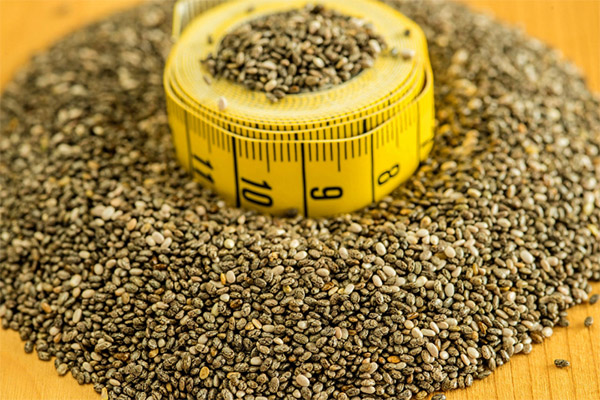
- The daily consumption rate is up to 2 tbsp. seed.
- After taking the seeds, they should be washed down with water.
- You need to eat seeds before training.
- Putting in salads should not be grain, but a gel made from them.
Seeds can be consumed as part of a variety of dishes, and in kind. Grains have a neutral taste, so they will not affect the quality of the finished product. Seeds should be washed down to avoid uncomfortable sensations in the stomach, since when the seeds swell, they acquire a jelly consistency. They can be used in the diet of vegetarians, as well as people who prefer plant foods.
To speed up weight loss, it is recommended to add chia seeds to vegetable and fruit smoothies. Such dishes will bring maximum benefits, enrich the body with nutrients and relieve hunger.
Chia seed oil: properties and applications
Oil is obtained by extracting it from chia seeds. It contains a large amount of omega-3 fatty acids, so the product is an excellent nutritional supplement. In addition, the oil has such useful properties:
- Improves liver function. The omega-3 fatty acid found in chia is also good for protecting the liver. Acids prevent lipotoxicity, fatty liver disease and dyslipidemia. Animal studies have shown that the product can help with dyslipidemia and insulin resistance. Alpha-linolenic acid redistributes fats from the liver to other organs, thereby preventing disease. Also, the acid normalizes the activity of various liver enzymes.
- Helps with rheumatoid arthritis. Oil prevents rheumatoid arthritis, as it has anti-inflammatory properties.
- Antioxidant protection. The amount of antioxidants in chia oil is greater than in chia seeds. The extract is very useful for stimulating the functioning of various enzymes that help the body fight substances harmful to it.
- Natural sweetener. Chia oil can also be used instead of sugar. Sucrose or other carbohydrate-rich sweeteners are usually used, but chia extract is a more useful alternative, so it is recommended to use it.
- Supports skin health. Chia oil is considered one of the most beneficial for the skin. It improves skin hydration and reduces the occurrence of cracks on its surface. Thus, it can be used as an effective moisturizer for skin itching or rashes.
- Supports healthy hair. Chia oil is a rich source of proteins, copper, zinc, alpha-linolenic acid and iron. These elements are necessary for hair growth and strengthening. Copper stimulates the production of pigment, melanin and alpha-linolenic acid help neutralize dry scalp, iron is needed for oxygen transport, and zinc is needed in the production of new hair.
The daily intake of chia oil is 1-2 teaspoons. Postmenopausal women are allowed to consume up to 25 g per day.
Chia oil is widely used in the field of cooking. The product has a neutral taste, so it can be used in many dishes, while the taste is not changed. Oil is great for adding to yogurts, cereals and soups (cold). It is important to note that the extract contains acids, which in the case of heat treatment disappear from the product. Oil can also be consumed in this way - drink 1 teaspoon on an empty stomach, preferably in the morning. It also goes well with smoothies and various cocktails.
Oil can also act as a cosmetic, as it has a nourishing effect on the blood vessels and pores on the face. It is perfect for women with dry skin. For people whose skin is drying, you should wipe your face with a few drops of oil once a day. This will significantly improve color and significantly improve the skin as a whole. The oil contains a lot of antioxidants that help heal wounds and nourish skin cells. In addition, the oil has a calming effect in case of acne, redness and skin irritation. The effect of antioxidants on the body is the rejuvenating effect and slowing down the aging process.
Oil also helps to strengthen the hair and nourishes them with beneficial substances. To feel the effect of its use, after washing the hair, rub 5-8 drops of oil into the scalp. You can also use hair conditioner, adding about 20 drops of oil to it - this will help to heal, moisturize and strengthen the hair. Oil is a rich source of protein, so it stimulates hair growth, and the zinc contained in the product will support cell renewal and regeneration.
Chia seeds in medicine
Chia seeds in the field of medicine are used as biologically active additives, along with them, herbal decoctions are prepared, and various products are made to facilitate the course of diseases or to prevent them.
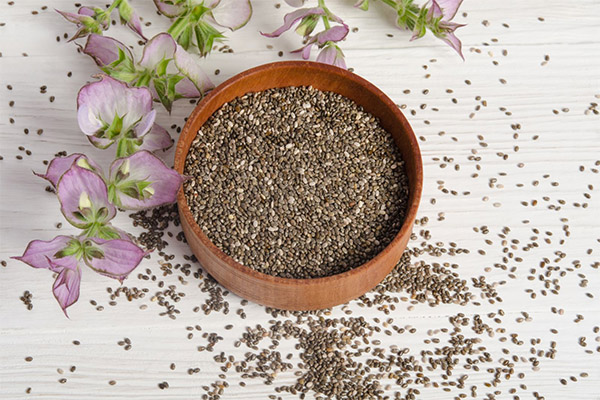
With diabetes
Rich in fiber, protein, and omega-3 fatty acids, chia seeds can support metabolic health and therefore regulate blood sugar. There are many studies that have shown that chia seeds can be a very effective natural treatment for diabetes, all thanks to their ability to slow digestion.When interacting with a liquid, a gelatin shell forms, which prevents sugar spikes, which has a positive effect on the glucose balance in the blood. Of course, chia seeds are not a panacea, but this product is an effective tool in the treatment of diabetes.
The daily recommended intake is 37 g of seeds, and the course should not last more than 12 weeks.
Important: the glycemic index of chia seeds is 30 units.
With pancreatitis
With pancreatitis, eating seeds is possible and even necessary. To feel the effect of the product, you should consume 30 g of seeds up to 3 times a day, while they need to be washed down with plenty of water. The course of treatment should last about 30 days, after which you need to take a 2-3-week break.
With gastritis
In gastritis, chia seeds are strictly forbidden, since fiber, when dissolved, has a negative effect on the stomach, damaging the inflamed mucous membrane.
For the intestines
Chia seeds are useful for the intestines, as they help to cleanse it, normalize stool and improve peristalsis. Use per day should not exceed 1-2 tsp. seed. The course to normalize the work of this body lasts up to 3 weeks.
For constipation
Constipation or difficulty emptying can cause severe discomfort. At the same time, accumulation of toxins in the body can lead to negative consequences. Chia seeds help cleanse the intestines of rotting food and feces. To improve stool, you need to take 2 tsp. grains and wash them with clean water (1 cup) without gas.
With gout
With gout, chia seeds are allowed. Seeds help restore metabolic processes leading to problems with tissues and joints. It is recommended to use the product along with vegetables, fruits, yogurts and cereals.
Chia seeds in cosmetology
The main purpose of the masks, which contain Spanish sage, is moisturizing, because the product helps maintain a normal level of moisture in the deep layers of the skin and prevents dehydration.
For face
Moisturizing mask
- Mix yogurt (250 ml) with egg whites (2 pcs.). In the resulting mass add chia seed oil (15 ml).
- Apply the mask to the skin of the face (pre-prepared). Hold for 10 minutes. Wash your face with cool water.
Scrub for delicate skin
- Mix the seeds (2 tablespoons) with coconut oil (125 ml) and lemon juice (1 tablespoons).
- Moisten your face with warm water and apply the mixture to it.
- Keep 2-3 minutes. Wash your face with cool water. Remove mask with a damp washcloth.
Mask with lifting effect
- Soak chia seeds (2 tablespoons) in water (3 tablespoons). Allow the mixture to infuse for 12-15 minutes (until swelling).
- Add honey (1 tsp) to the mixture and mix.
- Apply the mixture to the face. Hold for 10 minutes. Wash your face with water.
For hair
Mask for hair restoration
- Pour seeds (80 ml) with water (500 ml). Beat well and leave for 7-10 minutes.
- Beat the mixture one more time and send it to the refrigerator (for 15 minutes).
- After removing from the refrigerator, add lemon juice (45 ml) to the mixture and mix.
- Apply mixture to hair. Hold for 15 minutes. Rinse hair with cool water.
Mask using chia seed oil
- Mix with burdock and coconut.
- Apply oil to the hair and rub it into the roots actively.
- Hold for 2 hours. An ideal application is to withstand all night. You can wear a special hat on your head.
- Wash your hair with shampoo and then rinse your hair with lemon juice (diluted).
Harm and contraindications
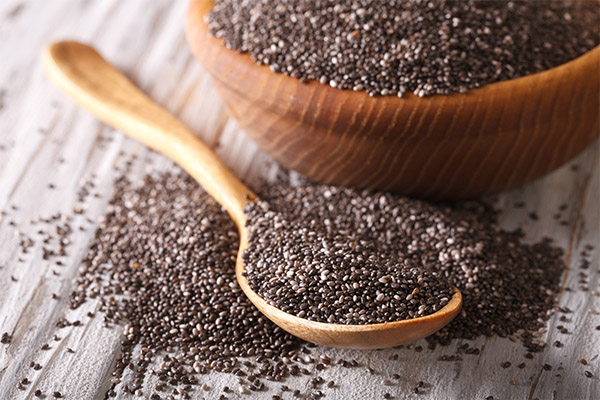
- People with gastrointestinal problems need to be careful about consuming seeds, as they can cause excessive flatulence and bloating.
- Also, this product can cause allergies, which are expressed in digestive disorders, rashes on the skin or even difficulty breathing.
- People who are allergic to mustard or sesame seeds should also be wary of this product.
- Under reduced pressure, the seeds are not recommended for use. In cases of taking drugs to regulate pressure, you should consult a doctor about the use of seeds.
- Grains are strictly prohibited in cases of acute diseases, especially related to violations in the digestive tract.
- During pregnancy, it is worth reducing the dosage, and in case of side effects, generally exclude the product from the diet.
- Due to the hard shell of the seeds, it is not recommended to use them in cases of diseases of the mucous membrane of the mouth and gums.
How to choose and store chia seeds
You can buy seeds at a pharmacy, health food store or even in an online store. It is important to pay attention to product quality. Here are some signs of grain quality:
- Heterogeneous color of seeds, inclusions and patterns of brown shades, the presence of white grains.
- A rounded shape resembling miniature quail eggs.
- Unflavored taste, slightly revealing with walnut.
- Lack of smell. Sometimes a slight smell of flour may be present.
After purchase, the seeds should be poured into an airtight container and placed in a dark place for storage at temperatures up to 25 ° C. It is important that the product is not exposed to sunlight, there is no humidity.
How to use chia seeds
Seeds can be consumed both in their natural form and as an ingredient in various dishes. For example, you can sprinkle seeds with oatmeal, yoghurts, or other healthy dishes and foods. When seeds are added to wet food, they soften, so they may not even be visible in the dish. Grains can also be used for making cereals, puddings, smoothies, and even for baking, if you previously grind them into flour.

How much can you eat per day
Experts do not recommend consuming more than 15 g (about 1 tablespoon) of chia seeds per day on an ongoing basis.
Can I eat at night and on an empty stomach
The best time to eat chia seeds is morning and evening. In the morning it is recommended to eat seeds on an empty stomach, while they can be mixed with dairy products. In the morning, the product will fill the body with energy, and in the evening before going to bed it will give satiety, which will help to avoid overeating.
Do I need to wash chia seeds before eating
You need to wash the seeds only before taking the product directly, because after contact with water the grains may disappear for several hours.
What can be prepared from chia seeds: recipes
Chia seeds are a fairly versatile product, as it provides a wide field for experimentation. They are excellent with cold appetizers, salads, sauces and various desserts. For those who want to include this product rich in beneficial substances in their diet, it is recommended to take note of some simple recipes.
Porridge
Ingredients:
- coconut milk - 50 ml;
- agave syrup - 1-2 tbsp .;
- water - 150 ml;
- chia seeds - 3 tablespoons;
- banana - 1 pc.
How to cook:
- Mix seeds in a deep bowl with coconut milk and agave syrup. Mix well, add a little water in the process. Stir until smooth.
- Leave to infuse for 2 minutes (in parallel, you can cut some fruits and berries).
- Add fruit and berries to the finished porridge.
Smoothie
Ingredients:
- berries (any, preferably frozen) - 1 cup;
- pomegranate juice (natural) - 0.5 tbsp .;
- water - 0.5 tbsp .;
- chia seeds - 0.5 tbsp
How to cook
Mix the berries with juice, water and seeds in a blender and beat. Pour the resulting mixture into a glass.
Pudding
Ingredients:
- chia seeds - 4 tbsp;
- Mango - 1 pc.;
- Coconut milk - 250 ml;
- vanilla essence - 10 drops;
- sweetener (any);
- fresh mint.
How to cook:
- Mix coconut milk with seeds, vanilla and sweetener. Refrigerate for 6 hours to thicken.
- Kill the mango in a blender.
- Transfer the pudding into glasses, put whipped mango and fresh mint on top.
Interesting Facts About Chia Seeds

- Although chia seeds have gained popularity over the past few years, they have been a staple in the diets of Native Americans and Mexicans for hundreds of years. They were used for making bread, cereals, as well as for medicinal purposes.
- Chia seeds can absorb large amounts of fluid. When the product is soaked in water, vegetable milk or any liquid, a gelatin mixture is formed, which is ideal for creating creamy pudding or a thick sauce.
- Seeds were widely used by ancient tribes to maintain strength and endurance in battles or during long campaigns. One of these tribes (until now living in the same territories) are the Taraumara Indians living in Mexico. They became famous throughout the world for having extraordinary stamina and the ability to run for quite long distances. However, the most interesting fact is that they still use chia seeds to nourish strength during their runs.
- Chia seeds at some point in history were used as monetary units. Highly valued by the Aztecs, grains were one of the main means of payment at that time. The nationalities and communities that were conquered by the Aztecs paid them tribute precisely with the seeds of chia. In ancient documents there is evidence that the Aztecs collected up to 4 thousand tons of seeds per year from their colonies.
- About 500 years ago, the Spanish invaders destroyed almost the entire sowing of chia plants. When the conquistadors stepped onto the shore of South America, they met locals who were very reverent about chia seeds. The invaders forced the aborigines to destroy all crops. This was done in order to establish their rules and show the indigenous people that their possessions no longer belong to them.
- In the 1990s, Dr. W. Coates rediscovered chia. The doctor was the project manager who aimed to find potentially profitable cash crops in Argentina. He managed to test various plants, which allowed him to determine the commercial potential of each of them. When chia seeds were discovered and thoroughly examined, the scientist decided to devote his efforts and time to restore this particular crop so that people around the world could take advantage of these grains.
- Insects do not like chia, so they do not harm the plant, which allows it to actively develop without the use of pesticides.
«Important: all information on the site is provided exclusively in fact-finding purposes. Before applying any recommendations, consult with a profile specialist. Neither the editors nor the authors are liable for any possible harm caused materials. "

